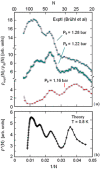Magic Numbers in Boson 4He Clusters: The Auger Evaporation Mechanism
- PMID: 34684825
- PMCID: PMC8537914
- DOI: 10.3390/molecules26206244
Magic Numbers in Boson 4He Clusters: The Auger Evaporation Mechanism
Abstract
The absence of magic numbers in bosonic 4He clusters predicted by all theories since 1984 has been challenged by high-resolution matter-wave diffraction experiments. The observed magic numbers were explained in terms of enhanced growth rates of specific cluster sizes for which an additional excitation level calculated by diffusion Monte Carlo is stabilized. The present theoretical study provides an alternative explanation based on a simple independent particle model of the He clusters. Collisions between cluster atoms in excited states within the cluster lead to selective evaporation via an Auger process. The calculated magic numbers as well as the shape of the number distributions are in quite reasonable agreement with the experiments.
Keywords: Auger evaporation; Van der Waals bonds; cluster supersonic jets; helium clusters; magic numbers.
Conflict of interest statement
The authors declare no conflict of interest.
Figures



References
-
- Northby J.A. Structure and binding of Lennard-Jones clusters: 13≤N≤147. J. Chem. Phys. 1987;87:6166–6177. doi: 10.1063/1.453492. - DOI
-
- Stephens P.W., King J.G. Experimental Investigation of Small Helium Clusters: Magic Numbers and the Onset of Condensation. Phys. Rev. Lett. 1983;51:1538–1541. doi: 10.1103/PhysRevLett.51.1538. - DOI
-
- Pandharipande V.R., Zabolitzky J.G., Pieper S.C., Wiringa R.B., Helmbrecht U. Calculations of Ground-State Properties of Liquid 4He Droplets. Phys. Rev. Lett. 1983;50:1676–1679. doi: 10.1103/PhysRevLett.50.1676. - DOI
-
- Melzer R., Zabolitzky J.G. No magic numbers in neutral 4He clusters. J. Phys. A Math. Gen. 1984;17:L565–L568. doi: 10.1088/0305-4470/17/11/002. - DOI
-
- Sola E., Casulleras J., Boronat J. Theoretical Search for Shell Effects in 4He Clusters. J. Low Temp. Phys. 2004;134:787–792. doi: 10.1023/B:JOLT.0000012645.43136.f2. - DOI
LinkOut - more resources
Full Text Sources

